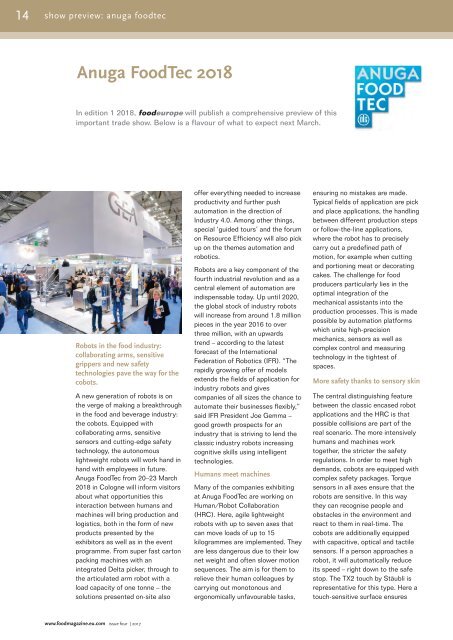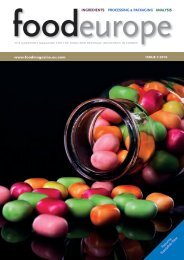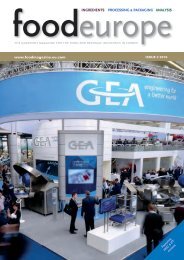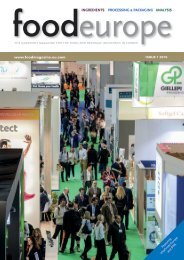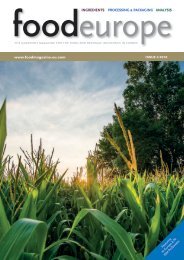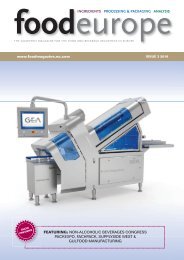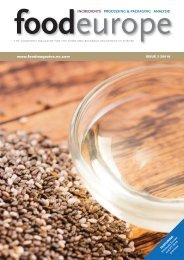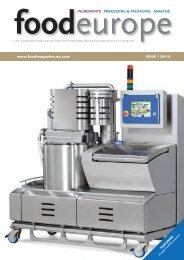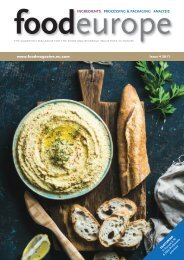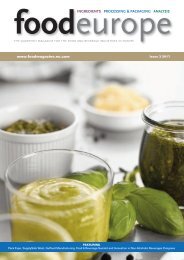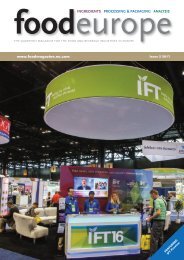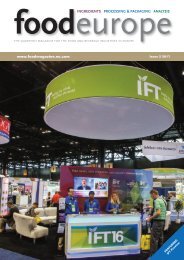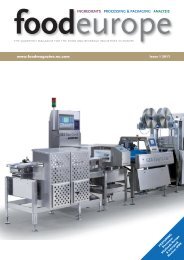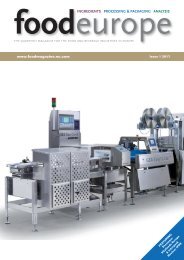Issue_4_2017
You also want an ePaper? Increase the reach of your titles
YUMPU automatically turns print PDFs into web optimized ePapers that Google loves.
14<br />
show preview: anuga foodtec<br />
Anuga FoodTec 2018<br />
In edition 1 2018, foodeurope will publish a comprehensive preview of this<br />
important trade show. Below is a flavour of what to expect next March.<br />
Robots in the food industry:<br />
collaborating arms, sensitive<br />
grippers and new safety<br />
technologies pave the way for the<br />
cobots.<br />
A new generation of robots is on<br />
the verge of making a breakthrough<br />
in the food and beverage industry:<br />
the cobots. Equipped with<br />
collaborating arms, sensitive<br />
sensors and cutting-edge safety<br />
technology, the autonomous<br />
lightweight robots will work hand in<br />
hand with employees in future.<br />
Anuga FoodTec from 20–23 March<br />
2018 in Cologne will inform visitors<br />
about what opportunities this<br />
interaction between humans and<br />
machines will bring production and<br />
logistics, both in the form of new<br />
products presented by the<br />
exhibitors as well as in the event<br />
programme. From super fast carton<br />
packing machines with an<br />
integrated Delta picker, through to<br />
the articulated arm robot with a<br />
load capacity of one tonne – the<br />
solutions presented on-site also<br />
offer everything needed to increase<br />
productivity and further push<br />
automation in the direction of<br />
Industry 4.0. Among other things,<br />
special ‘guided tours’ and the forum<br />
on Resource Efficiency will also pick<br />
up on the themes automation and<br />
robotics.<br />
Robots are a key component of the<br />
fourth industrial revolution and as a<br />
central element of automation are<br />
indispensable today. Up until 2020,<br />
the global stock of industry robots<br />
will increase from around 1.8 million<br />
pieces in the year 2016 to over<br />
three million, with an upwards<br />
trend – according to the latest<br />
forecast of the International<br />
Federation of Robotics (IFR). “The<br />
rapidly growing offer of models<br />
extends the fields of application for<br />
industry robots and gives<br />
companies of all sizes the chance to<br />
automate their businesses flexibly,”<br />
said IFR President Joe Gemma –<br />
good growth prospects for an<br />
industry that is striving to lend the<br />
classic industry robots increasing<br />
cognitive skills using intelligent<br />
technologies.<br />
Humans meet machines<br />
Many of the companies exhibiting<br />
at Anuga FoodTec are working on<br />
Human/Robot Collaboration<br />
(HRC). Here, agile lightweight<br />
robots with up to seven axes that<br />
can move loads of up to 15<br />
kilogrammes are implemented. They<br />
are less dangerous due to their low<br />
net weight and often slower motion<br />
sequences. The aim is for them to<br />
relieve their human colleagues by<br />
carrying out monotonous and<br />
ergonomically unfavourable tasks,<br />
ensuring no mistakes are made.<br />
Typical fields of application are pick<br />
and place applications, the handling<br />
between different production steps<br />
or follow-the-line applications,<br />
where the robot has to precisely<br />
carry out a predefined path of<br />
motion, for example when cutting<br />
and portioning meat or decorating<br />
cakes. The challenge for food<br />
producers particularly lies in the<br />
optimal integration of the<br />
mechanical assistants into the<br />
production processes. This is made<br />
possible by automation platforms<br />
which unite high-precision<br />
mechanics, sensors as well as<br />
complex control and measuring<br />
technology in the tightest of<br />
spaces.<br />
More safety thanks to sensory skin<br />
The central distinguishing feature<br />
between the classic encased robot<br />
applications and the HRC is that<br />
possible collisions are part of the<br />
real scenario. The more intensively<br />
humans and machines work<br />
together, the stricter the safety<br />
regulations. In order to meet high<br />
demands, cobots are equipped with<br />
complex safety packages. Torque<br />
sensors in all axes ensure that the<br />
robots are sensitive. In this way<br />
they can recognise people and<br />
obstacles in the environment and<br />
react to them in real-time. The<br />
cobots are additionally equipped<br />
with capacitive, optical and tactile<br />
sensors. If a person approaches a<br />
robot, it will automatically reduce<br />
its speed – right down to the safe<br />
stop. The TX2 touch by Stäubli is<br />
representative for this type. Here a<br />
touch-sensitive surface ensures<br />
www.foodmagazine.eu.com issue four | <strong>2017</strong>


